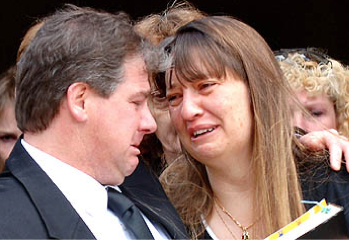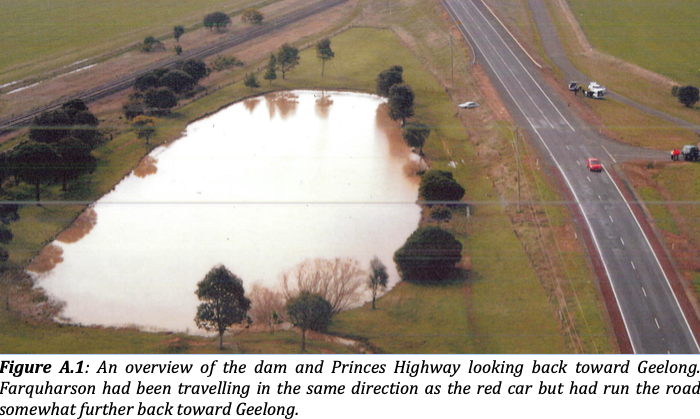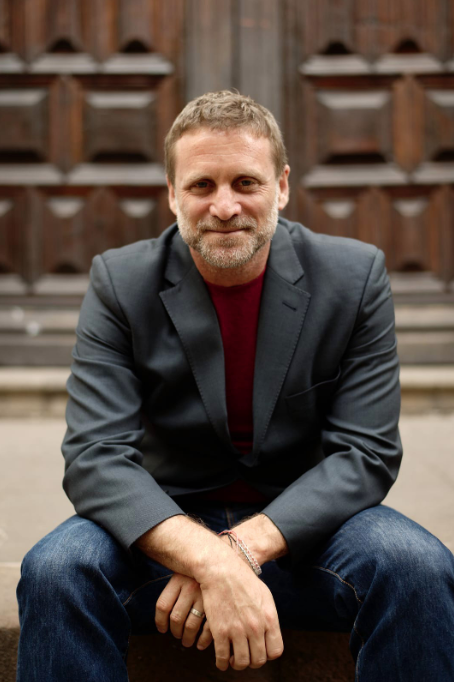Andrew L. Urban.
In his important new book, Road to Damnation, Chris Brook takes the reader on a gripping journey to the darkest reaches of human experience – the drowning of three children – when it intersects with the law. Brook places the case of Robert Farquharson – their father – at the interface between law, science, society and psychology. We invite our readers to ‘hit the road’ in a series of extracts, starting next week. First, we preview the book, which is destined to be controversial.
It is pitch black. Jai is shaking him. ‘Daddy, daddy.’ He is dazed, at the wheel. He starts to feel around. We are off the road, he thinks, must be in a ditch. But then Jai starts to open the passenger door and water starts rushing in. So begins Chapter 1 – Damned, grabbing our imagination as Chris Brook begins to tell the story that started in country Victoria on that dark Father’s Day night in 2005, and after several turns and twists over the years, continues still, in a prison cell where Robert Farquharson is destined to spend his days and nights for 33 years. And Brook shows how wrong and how avoidable that outcome has been.
It’s the third book on the case, but the only one whose author spoke extensively to Farquharson.
With degrees in law and science from the University of Melbourne and astrophysics from Swinburne, Brook (now an astrophysicist at a world leading institute in Spain) has the perfect amalgam of disciplines to deconstruct this case, which continues to be misrepresented and misunderstood. The emotional branding mark of infanticide is impossible to erase, it seems. But Brooks gives it a good go.
In 2007, Farquharson was convicted and sentenced to life imprisonment with no minimum term. However, he maintained his innocence and appealed his sentence. On 17 December 2009, he won the right to a retrial, due in part to the key witness for the prosecution, Greg King, facing potential criminal charges himself at the time of the original trial. He was released on bail on 21 December, but was again convicted of murder on 22 July 2010. He claims he blacked out after a coughing fit and lost control of the car, which veered off the road into a dam and sank. He escaped but could not save his sons. The prosecution claimed he drowned his sons deliberately.
“The book analyses the evidence in the case from a scientific perspective, making comparisons with the way the evidence was analysed in the criminal justice system. Scientific knowledge such as memory research, and the profound implications for our legal system, is explained and explored, as are cognitive biases, and how barristers exploit them to manipulate juries.” That’s how he pitches the book and it is perhaps the most remarkable aspect of Road to Damnation – that it combines investigative and scientific methods and presents the material in an accessible and highly engaging manner. We are with him on the road, following the evidence and his analysis.

Robert Farquharson and Cindy Gambino console each other at the funeral of their three boys
“When Farquharson told me the story of what happened the night his children died I believed him. Not because he sounded earnest, and not because he looked me in the eyes, as though that matters. I believed him because I had spent the past two years looking closely at the evidence used to convict him, and had concluded that the evidence indicates that he is innocent.”
It isn’t a heavy book, either to read or to carry, at some 85,000 words and comes in 25 chapters (plus 4 Appendices), logically and relentlessly leading the reader to the damnation of the conviction. Brook’s search for the truth reveals the errors and preconceptions that turn the investigators and the prosecution blind – a cruel twist on the notion that it is lady justice who is supposed to be blind.
In Chapters 1 & 2, he lays out the background of the facts of the case. Farquharson is a divorced father of three driving his three children home from father’s day dinner. The car veers off the road into a dam. Farquharson claims he blacked out following a coughing fit.
Then in Chapter 3, he reviews evidence of how Farquharson’s survival, and his inability to save his children, is portrayed (negatively) in the trial and in public opinion.

By Chapter 8, we are deep in traumatic territory. Brook explains the pressures the forensic analyst in the case came under, due to being part of the police force rather than an independent scientist. These pressures not only affected the results of his analysis, but also affected his mental health.
Chapter 11 looks at the medical diagnosis and how it was made. Brook explains science’s focus on ‘likelihoods’ rather than ‘absolutes’, placing the evidence in this context.
Chapter 18 looks at the psychology of ‘paying attention’ and how barristers exploit natural inabilities to absorb details to which we are not paying attention to discredit witnesses and in particular the accused.
Along the way – or the road – Brook explains why miscarriages of justice occur, and how they can be prevented. That’s another reason why his book is so important; if only the entire legal profession and all its apparatus would read it and embrace the need for reforms, perhaps starting with a Criminal Cases Review Commission to serve the whole country.
A CCRC is something that has the support of former High Court judge Michael Kirby and leading forensic pathologist Professor Stephen Cordner, among many others. Legal academic, Dr Bob Moles has recently articulated how such a body might be established in Australia, in a letter to Attorney General Christian Porter:
A national CCRC can be established by setting up a single CCRC and then each state and territory can legislate to nominate that CCRC as the appropriate agency to review cases on its behalf and exercise powers given to the CCRC by that state to refer matters to the appeal court of that state. This would not involve any constitutional change of any sort.
In essence, instead of duplicating the overheads of a CCRC eight times by having one in each state, we save resources by having a single body exercising the appropriate powers for each state and territory.
For those wrongfully convicted and having lost their appeals like Robert Farquharson, a CCRC could offer a road to salvation.
ROAD TO DAMNATION (Clear Decks Media) $19.99 (paperback) $9.99 (e-book)
Available at Amazon

Chris Brook
Chris Brook is a theoretical astrophysicist who works on the formation of galaxies, trying to understand what galaxies can tell us about the nature of dark matter. He works at the University of La Laguna and the Instituto de Astrofísica de Canarias, one of Spain’s most prestigious science institutes. Chris has previously held scientific research positions in universities in Australia, Canada, the U.S. and the U.K., has published more than 80 refereed journal articles that have been cited several thousands of times, and has been invited to talk at conferences and universities throughout the world. As well as a bachelor science and doctorate in astrophysics, Chris also has law and commerce degrees, and has published work on issues in forensic science. Chris has a particular interest in miscarriage of justice, particularly in the way that the legal system engages science, and how misunderstandings and ignorance of scientific knowledge can lead to injustice. Chris grew up in Melbourne, and now lives in Tenerife, Spain, with his wife Arianna and daughter Miranda.
NEXT: Excerpt 1 from Road to Damnation – ‘I blacked out’

Very happy to be a signatory to your ‘grass roots movement’ Jill. Well done.
As I commented earlier, look what ICAC is establishing amongst those who believe they are professional and so called community minded, when in fact all they turn out to be is infamous democratically elected representatives. They are a scourge on the politicians who want to do the credible thing.
These same infamous people may even get to decide if a body of justified legislation should prevail, when keeping in mind, there are many lives being constantly impacted by wrongful convictions.
We must continue to believe that it’s just a matter of time before the grassroots movements in our society gets through to the responsible politicians who can achieve real justice with the establishment of a CCRC.
The penny will drop soon! The sooner, the better.
This book is a great read. Highly recommended, even though I haven’t finished reading it yet.
I also read Helen Garner’s House of Grief, whch has a serious flaw in it, in my opinion. Helen’s other books (many of which I have read – I am a big fan of hers) lack the error she made in this case, in my opinion.
Sorry to be replying a year late, but what is the serious flaw in This House of Grief? I’m not saying there isn’t one, just curious as to your opinion.
It’s just my opinion ……
Helen Garner shows great insight and understanding in all the other books of hers that I have read. As well as choosing her words well. A great writer. But …..
At the start of House of Grief, Helen has an open mind, like Chris Brook does in his well-researched book Road to Damnation. Pardon that I don’t have Helen’s book with me, so I’m writing this from memory.
There’s an early scene in a courtroom. Helen sees Robert F shuffle past, looking like a lost soul. Helen comments to the young friend sitting next to her about feeling a bit sorry for Robert F, who looks so pitiful. A female journalist turns to Helen and berates Helen: “How dare you? I was at the funeral.” ….. implying that the journo knows better because the journo was at the funeral.
The next couple of pages are the saddest part of any Helen Garner book I’ve ever read, because in my opinion Helen wrongly downplays her own open-minded opinions and is sort of “what would I know, the journo knows better.” And Helen is so so wrong to think that. The rest of the book in my opinion has a tendency to treat Robert F as guilty, even though the evidence in my opinion strongly indicates his innocence.
The funeral of three dead children is a sea of agony, of sadness, of emotion. When emotion rules instead of logic, false conclusions are reached. Some prosecutors of a dubious case want emotion, not logic, to rule, not for justice, but to win.
Pardon my diversion into a tangent ….. when the public in Tasmania (via the newspapers) and the jury (via the speculation-laden portrait of Sue as a liar by the prosecutor) developed negative thoughts about Sue Neill Fraser, the chances skyrocketed that the speculative case against her would succeed. Ditto Lindy Chamberlain. When the prosecutor can get the jury to think emotionally instead of rationally, the chances of a wrongful conviction are enhanced.
Ditto the Kathleen Folbigg, Keli Lane, Simon Gittany, Gordon Wood and Robert Xie cases, amongst others. End of tangent.
The serious flaw is that Helen, being relatively unfamiliar with the trademark signs of an innocent person being wrongly accused, from that moment onwards puts aside her own judgement (full of doubts). Instead Helen trusts the emotional judgements of others such as the journo and Helen’s young student friend who naively fell for the emotional factor when there’s a desire to blame someone for the deaths of children.
So my opinion is that the book is flawed – Helen puts aside her many doubts (though she mentions them) and allows the reader to drift alongside Helen into a view – which I obviously do not share – that Robert F is guilty.
As a result, an excellent, totally logical book by someone like Chris Brook will be ignored. The community, via Helen’s book, “knows” that Robert F killed his kids on purpose. But I’m pretty sure he didn’t, and I think it’s so sad – this wrongful conviction will never be rectified.
PS: I’m from NSW and know none of the participants in this sad saga.
Thanks for the response!
My take on Garner’s book is that she wanted him to be acquitted but can’t bring herself to admit that – possibly even to herself, and so she’s not really expressing what she honestly believes, and the book suffers for that.
From my own memory – in lockdown we have to rely on memory a lot – I had to read Megan Norris’s book to learn that the judge (a very experienced criminal lawyer) summed up for an acquittal.
Had I been a juror I would have voted to acquit.
I’m looking forward to Chris’s book. I’ve got a copy on order.
https://www.theguardian.com/books/australia-culture-blog/2014/aug/20/this-house-of-grief-by-helen-garner-review-haunting-true-account-of-an-accused-murderer
The online reviews of Road to Damnation are pretty amazing. Amazon has six reviews – all five stars. Goodreads has three reviews – all five stars. Booktopia has three reviews – all five stars. I have never seen such uniform 5/5 star reviews for any book ever.
My personal view is that the book deserves such consistently excellent reviews. Presenting both sides, providing link after link to scientific information to back up every point, in my opinion this book explains better than any other true crime book how and why things can and do wrong at criminal trials. Overall, the best true crime book ever, in my opinion. Not a widely read book, however.
The relevance is not just to the Farquharson case – the material in the book is eye-opening to anyone who wonders how on earth the Sue Neill Fraser case unfolded as it did.
If you want to know the ins and outs of Tim Ellis and the police portraying Sue Neill Fraser as a liar, read the chapter Pants On Fire. If you wonder why the memories of so many eye witnesses near the yacht might not be as accurate as we’ve been educated to believe, read chapters 12 to 15. Etc.
The explanations in this book explain not only about the Farquharson case, but also provide the material so you can better understand what went wrong in almost any other trial. The book is a revelation.
@wrongfulconvictionsaustralia facebook page has commenced a change.org petition to all the state and federal attorney generals calling on the establishment of a CCRC in Australia…none of us at Wrongful Convictions Australia are professional writers, academics, or famous. We are mainly people who know someone who has been wrongfully convicted. I’m not sure how effective change.org petitions are, but it can’t do any harm if it doesn’t do any good. We also plan on starting a letter/email writing campaign in the new year. We are a grass roots movement who would appreciate support for this cause, by signing and sharing the petition. https://www.change.org/CCRC4AUSTRALIA
well done. Will support.
Appreciate that Andrew.
I obviously missed that blog but on reading it I feel compelled to add to my most recent comments, particularly the final sentence and add “,with the exception to NZ who have demonstrated that their lawmakers, their politicians, are listening and have nothing to fear by legislating for a CCRC. The proof is in the pudding.
Just look at the result of this weekends election in NZ.
Says it all.
Thank you for your follow up to my interest in Dr Moles’ letter.
The calls for a CCRC has no greater an example than what is currently happening at ICAC this week bringing to the surface the murky nature of lawmakers who we are witnessing to be dishonest in their dealings and abusers of their own self made laws. These are the people we would have looked up to at one time and the same people we are asking to consider legislation for a CCRC.
What a blight on their democratically elected and public positions.
I note in your article above Andrew, that Dr Bob Moles “has recently articulated how such a body (CCRC) might be established” and I could think of no better a advocate than he to do this.
I would greatly appreciate knowing if Dr Moles’ letter is publicly available for future (acknowledged) referencing as I have sent letters seeking the establishment of a CCRC in the past to many such elected representatives and public figures only to receive a few replies which, of course, are all sent from the minders of these elected representatives and public figures.
Not even being acknowledged on the many other occasions is an indication that their interest is only in matters that come before a body such as ICAC where they are found to be frequently communicating ‘secretly’ with those who wish to ‘line their pockets’.
It is little wonder that the public has lost trust in our lawmakers, the politicians.
Jerry – Bob Moles’ letter to the AG about the CCRC is not publicly available but I will endeavour to make it so.
Actually, the most pertinent parts of the Moles letter to AG Porter are included in this story – https://wrongfulconvictionsreport.org/2020/05/24/another-ccrc-established-but-still-not-in-australia/